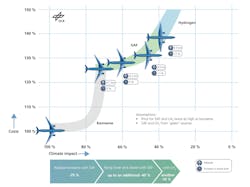Long-haul flights – small changes with a big climate impact
COLOGNE, Germany - Long-haul flights carry only around 10 percent of all passengers each year but generate approximately 40 percent of the carbon dioxide emissions due to air transport. This is due to the long distances and flight times involved. Even small changes in flight altitude and airspeed, together with the choice of energy source, can significantly reduce their climate impact. In addition, aircraft specially designed for flight at different altitudes will also make a decisive contribution to climate compatibility on long-haul routes. Researchers at the German Aerospace Center (Deutsches Zentrum für Luft- und Raumfahrt; DLR) have arrived at these conclusions as part of the KuuL (Klimafreundlicher ultra-effizienter Langstreckenflug; climate-friendly ultra-efficient long-haul flight) project. This work is part of DLR's extensive research commitment in line with its aviation strategy for climate-compatible flight, write researchers at the German Aerospace Center (DLR). Continue reading original article.
The Military & Aerospace Electronics take:
19 September 2023 - DLR notes that in the project, researchers compared traditional kerosene, carbon-neutral synthetic fuel, refered to as Sustainable Aviation Fuels (SAFs), plus hydrogen, alongside reduced flight altitudes and speed to design new aircraft
"No completely new aircraft need to be built for the use of SAFs. Our research shows that just switching from kerosene to SAFs reduces the climate impact by approximately 25 percent, without the need for new aircraft," explains Project Leader Martin Hepperle from the DLR Institute of Aerodynamics and Flow Technology. "The actual climate impact of carbon dioxide emissions can be reduced by 100 percent if the SAFs are produced using a carbon-dioxide-neutral process. This means that during the production of these synthetic fuels, only as much carbon dioxide is emitted as was previously removed from the atmosphere by plants or other processes," Hepperle explains.
The climate impact from aircraft engine emissions is also strongly dependent on the flight altitude. "If, in addition to a change of fuel, the maximum flight altitude is reduced by 2000 metres, a reduction in the climate impact of up to 70 percent can be achieved," says Hepperle. However, at this altitude, the aircraft design must also be modified due to the higher air density, and, in particular, the sweep angle of the wings must be reduced. The flight speed would also have to be reduced by up to 15 percent to remain energy efficient. "However, this would then require the development of new aircraft," explains Hepperle. As the climate impact is reduced, however, the operating costs increase because the aircraft can perform fewer flights per day. "In the long term, a compromise must be found here between energy demand, cost effectiveness and climate impact," says Hepperle.
Related: NASA and DLR jointly developing quantum computer software package
Related: NASA-DLR study finds sustainable aviation fuel can reduce contrails
Related: DLR and MTU Aero Engines study fuel cell propulsion system for aviation
Jamie Whitney, Senior Editor
Military + Aerospace Electronics
